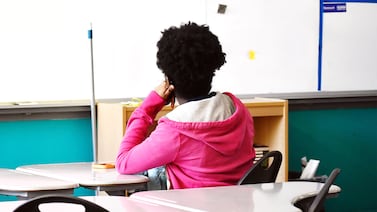Sign up for Chalkbeat Indiana’s free daily newsletter to keep up with Indianapolis Public Schools, Marion County’s township districts, and statewide education news.
Roughly the same number of Indiana high school seniors filled out the Free Application for Federal Student Aid this year as in 2023, despite this year’s rough rollout.
Indiana ranks first in the country for the least amount of year-over-year change in FAFSA submissions. As of June 14, the National College Attainment Network, or NCAN, tracker showed 39,800 FAFSA completions in the Hoosier State, down just 1.1% from 2023.
Delays and glitches have plagued the FAFSA filing process since a new version was fully released in January. The Indiana Commission for Higher Education and INvestEd worked with students and parents for months to complete as many submissions as possible before the state’s April 15 priority deadline.
“We are just a percentage away from matching last year’s filing, which is amazing when you think about the three-month shorter window and all the hurdles that families had to jump through,” said William Wozniak, INvestEd’s vice president of communications and student services.
Did Indiana meet FAFSA goals?
As of June 14, Indiana was no. 21 in the nation for the percentage of seniors completing FAFSAs with 44.7% — about 15 percentage points shy of the commission’s 60% goal. Earlier in May, CHE announced the state was in the top 10 for FAFSA submissions and completions, which was another goal.
The third goal, a 5% overall state increase in FAFSA filings, has not been met yet, though numbers are up, said Michelle Ashcraft, chief program officer at CHE. That statistic included high school, current college, and adult students.
Wozniak and Ashcraft said several factors contributed to the state’s FAFSA results, including extensive communication, the pre-admissions initiative, and a new state law requiring students to file.
“[Despite the delay], we still ran our typical event schedule in the fall. We focused on creating FSA IDs instead of filing the FAFSA. A lot of our communications throughout the semester were, ‘Hey, this thing is coming. We can at least help you take the first step to get ready.’ So when it opened fully in January, most of our students across the state were ready to go,” said Ashcraft.
“The commission was very active in reaching out to students and families about filing. We were thrilled that our contact information was included in that messaging so families could give us a call,” added Wozniak.
In the four days before the state deadline, INvestEd received more than 1,000 calls for FAFSA help, he said.
What counts toward April FAFSA deadline
Since students and parents submitted FAFSA information separately this year, Ashcraft said the commission used the student’s submission date for the deadline. This decision allowed parents to make edits and corrections later without affecting priority financial aid eligibility. When the government started sending files to the states and schools, errors were discovered that affected CHE’s ability to pinpoint the number of students who filed before April 15.
“We have had to go through two rounds of federal corrections that are separate from the typical process that individual students might have to do to correct their FAFSA,” Ashcraft said.
Once CHE can assess how many students filed before April 15, they can determine how much funding is going out, how much is left, and whether they can extend the priority deadline.
“Last year, we were able to extend the guaranteed funding deadline to June 30. The year before that it was August 31, and the year before that it was May 30. We try to award as far out into the summer as we can until we’ve exhausted the funding allocation for that year,” said Ashcraft.
Lingering issues with Social Security numbers
Ashcraft said one lingering FAFSA issue is helping students affected by Social Security number glitches. Another priority is helping students who filed a paper FAFSA to ensure they met the April 15 deadline. The federal government didn’t start processing those applications until June.
Anne and Mike Vandall of Fishers started the FAFSA filing process with their daughter, Emily, in February and didn’t finish until May. Emily plans to attend Saint Mary-of-the-Woods College.
“The biggest challenge was navigating once we were able to get in,” said Anne Vandall. “We did it intermittently because we would get to a certain point, and sometimes it would kick us out. But when we tried to go back in to resume, we weren’t sure where we were supposed to go.”
Ashcraft encourages families that had trouble filing or haven’t filed to complete the process as soon as possible because they’re still eligible for state and federal aid.
“We’re back to normal processing times,” she said. “It’s about a one- to three-day turnaround from the time the student files for that information to get to states and the institutions.”
Still time to fill out FAFSA for federal deadline
The federal FAFSA deadline is June 30, but that cutoff date is for the 2023-24 award year. The 2024-25 deadline is June 30, 2025.
“Let’s say somebody was going to school in January 2025. They weren’t going to go in the fall, but they’re going to go in the spring. The FAFSA has to stay open for the whole year,” said Wozniak.
As for the 2025-26 award year, Ashcraft said she thinks more participation in the pre-admissions initiative and the state law requiring FAFSA filing will boost submissions.
“I am grateful for the progress we’ve made in spite of all the challenges. It gives me hope that next year, if it opens on October 1 with no issues, we can make significant progress on that [60%] goal,” she said.
Wozniak added that families should stay ready for next year’s FAFSA form.
“We want them to have the best experience possible,” he said. “And we’ll be ready no matter what it looks like.”
Correction: July 1, 2024: A previous version of this story incorrectly stated that Indiana met its third goal, a 5% increase in overall FAFSA filings. Numbers are up, but the state hasn’t reached that goal.
Mitzi S. Morris is a freelance journalist. Contact Chalkbeat Indiana at in.tips@chalkbeat.org.







